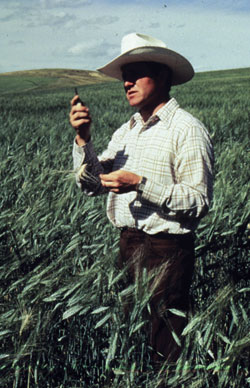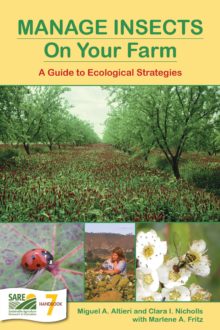
Rotation, Rotation, Rotation: Alfalfa, Clover Crops Break Pest Cycles
- uses crop rotations to diversify soil biology and to thwart pests
- Provides habitat for beneficial
- uses green manures to manage weeds
In Big Sandy, Mont., Bob Quinn hasn’t borrowed operating capital from the bank for 10 years. Without hefty bills for agrichemicals at planting — and with an effective year-round marketing program — his cash flow is more stable than it was in the mid-1980s, before he began converting his 3,000 acres to organic.
The north central Montana dryland farm sells its organic barley, buckwheat and wheats — hard red winters, durums and hard red and soft white springs — for at least 50 percent more, on average, than conventional farms do. It also produces organic lentils and — under Quinn’s Kamut® brand — the ancient Egyptian wheat khorasan. With fewer inputs and higher-value outputs, Quinn added a partner — Thad Willis — and another thousand acres. The expanded operation, now farmed entirely by Willis, supports two families instead of one. “That’s a different direction than most of agriculture is going,” says Quinn.Indeed.
Rotation, Rotation, Rotation
Quinn attributes the farm’s profitability to its soil-building, pest-thwarting, four- to five-year rotations. Its alfalfa, clover and grains are thick with predaceous lady beetles, and its last serious insect infestation was 15 years ago. “Most people can’t believe it,” he says. “For many years, people thought I was spraying at night. They couldn’t believe anyone could succeed without chemicals.”
Similarly, the viral diseases and root rots that used to sicken the farm’s grains are “mostly gone,” and pathogens flare only in the rare year when pre-harvest rains fuel black tip fungus in highly susceptible khorasan fields.
The farm’s green-manure based weed-control program “works as well as conventional spraying,” Quinn says: kochia has nearly disappeared (“I think it needs highly soluble nitrogen to compete with wheat”), wild oat seeds germinate more sparsely (“They’re a problem for us, but not nearly as much as you would expect with no chemicals”) and thistle is contained. Fanweed and mustards — which the partners unfortunately see more often now than they used to — succumb to the cultivator or to switchbacks between spring to fall planting.
With no large livestock operations nearby to supply manure, the farm’s “primary and only” instrument of soil improvement is green manure. In high-moisture years, that means weed-throttling alfalfa — underseeded in a grain crop the first year, hayed the second year and incorporated into the soil the third year. In intermediate-moisture years, the partners plant less-thirsty sweet clover with a companion grain the first growing season and disk or plow it under the second. In really dry years, they sow green-manure peas in the fall or green-manure lentils in the spring, turning them under by the first of June.
“I think the rotation and soil-building program we have in place allows a great diversity in soil biology, and that’s what keeps the pests in place,” Quinn says.
In their grain storages, Quinn and Willis dissuade pests with cool, drying air and with a dusting of insect-shredding diatomaceous earth laced with tempting pheromones. After they load their grain into bins, they level off the cones to eliminate peaks in which pest-supporting moisture and heat can concentrate.
Kamut®: World markets for local product
Because of his frequent and direct contacts with consumers, Quinn says he no longer thinks of himself as a commodity producer but instead as a grower of life- and health-sustaining food. He promotes and researches his Kamut® wheat worldwide when he’s not developing a 100-megawatt wind farm in central Montana. Khorasan wheats appeal to consumers who are allergic to other wheats or who value low glycemic indices and high concentrations of antioxidants. They are used in more than 400 kinds of products — primarily cereals in the U.S., breads in northern Europe and tarts, pastries and pastas in southern Europe.
The Egyptian government has discouraged production of that nation’s native khorasan wheat because of its low yield potential — a problem in Egypt’s high-input, modern irrigation systems. That’s not an issue in north central Montana, where dryland fields don’t have high yield potential to begin with. That’s precisely why khorasan is such a good fit, Quinn says. A 500-mile diameter area carved out of north central and northeastern Montana, southern Saskatchewan and southern Alberta is also the least likely to get rain when Kamut® wheat is most vulnerable to black tip — a dark discoloration of the germ end of otherwise healthy wheat kernels.
Rather than try to develop resistance to black tip, Quinn has used a post-harvest color sorter to “knock out the worst of it” when it occurs. “I’m not sure I want to breed in resistance,” he says. “We like the wheat the way it is and don’t want to take a chance on losing any of its wonderful qualities. So we’ve chosen not to tamper with it, to grow it in regions of the world where it’s most successful and to be satisfied with lower yields.” Besides, he notes, the lower numbers of bushels can be offset with higher prices.
Real results, real independence, real fun
Despite the partners’ profitability, Quinn says only a handful of farmers in their area have adopted similar practices. “It’s hard for a lot of people to change what they’re doing,” he says. “There are a lot of unknowns in this, and there’s also a transition period when you will certainly experience lower yields without getting the organic premium.” There’s another reason, too: The word being spread by agrichemical companies — and still coming down through traditional educational circles — is “that this it not real.”
It’s real all right, says Quinn, but it’s certainly not real easy. “It takes a lot more management and thinking ahead. So if you aren’t careful with your weeds, you can easily let them get ahead of you, and if you aren’t careful with your rotations, the system won’t work properly.”
Farmers who make it work, however, find they are working directly for their customers rather than for Uncle Sam. “It puts us in a position to be paid a livelihood by the consumers rather than relying on government payments — and I think that’s a very big plus,” says Quinn.
Besides, he adds, “It really brought the fun back into farming.”
